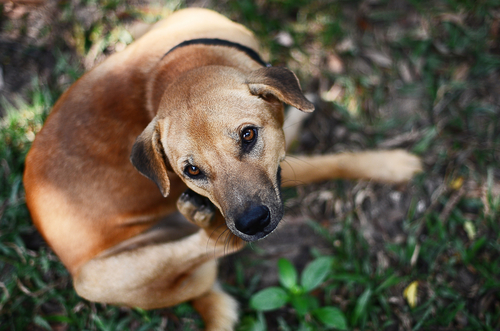Ctenocephalides felis (cat flea) is the most common ectoparasite in North America. He is not exclusive to cats despite his name. He is ubiquitous in environments with higher than 50% humidity. Only one stage (adult) of the flea life cycle is seen on animals and they only stay on the animal long enough to get a blood meal and lay eggs. The other three: eggs, larvae and pupae are an environmental infestation.

Eggs are deposited on animals and fall off into the environment within a few hours. Larvae cannot develop in direct sunlight, but prefer indoors or in shady areas where animals rest. They can develop indoors in protected spots, like along baseboards or under furniture. Larvae develop into pupae and the speed depends on temperature and humidity.
Pupae develop into adults 8-13 days later, but if no environmental stimulus precipitates development, the adults can rest in the cocoon for up to a year. Mechanical pressure (passing animals or people), increased carbon dioxide (animals or people breathing) or an increase in temperature can stimulate emergence. Adults emerge ready to bite.
Cat fleas can survive for days at temperatures slightly above freezing, so in fairly temperate climates, fleas are a problem all the time.

No resistance has been demonstrated scientifically to veterinary flea control products, but some experts have said that flea populations, especially in my area (the Southeast) are becoming strong and that the older products are becoming less effective. I am not hearing negative results from the newer oral products yet, however.
Here’s what you need to know:
All dogs need protection and always exactly as directed.
Just because you do not SEE adult fleas does not mean that your dog does not have them. All dogs in the summer (and many climates require year-round protection) need to be protected.
The newer veterinary products are your best hope.
Anecdotally clients are reporting that the older products do not seem to be as effective as they once were, but I am not hearing issues with the newer products… yet.

Treat your environment too.
Environmental management is absolutely required to gain control of the fleas. Treatment of the premises with a product designed to prevent egg hatching and larval maturation is instrumental in halting and preventing an infestation. It is not usually possible to stop fleas at the pupal stage, but regular vacuuming can stimulate pupae to emerge to adults where they can be killed by adulticidal products.
Just because you do not have carpet, does not mean that you do not have fleas.
Fleas like protected areas, like under furniture and along baseboards.
If you are using a veterinary product (purchased from your veterinarian-see Counterfeit Products online) and you are still seeing fleas, ask your vet to help. He or she might be able to figure out which step needs to be more thoroughly addressed.
 Toledo, United States.
Toledo, United States.